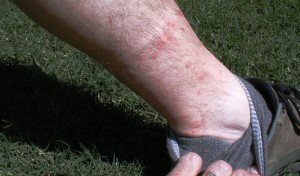 It is now time to talk about the CHIGGER! If these little guys weighed five pounds everyone would be packing shotguns. In the case of chiggers, the best defense is a good offense. Chiggers come into our environment from wildlife including birds, mammals and reptiles. They like an undisturbed environment. To keep chiggers at bay start by disturbing their environment. Keep your lawn mowed, watered and fertilized on a regular basis. In other words, maintain your lawn! The next step is trying to control the wildlife in the yard. This means taking down the bird feeder for a month or two. There are many good options to keeping these undesirable pests away, both organic and synthetic. Click here to read more about chiggers.
It is now time to talk about the CHIGGER! If these little guys weighed five pounds everyone would be packing shotguns. In the case of chiggers, the best defense is a good offense. Chiggers come into our environment from wildlife including birds, mammals and reptiles. They like an undisturbed environment. To keep chiggers at bay start by disturbing their environment. Keep your lawn mowed, watered and fertilized on a regular basis. In other words, maintain your lawn! The next step is trying to control the wildlife in the yard. This means taking down the bird feeder for a month or two. There are many good options to keeping these undesirable pests away, both organic and synthetic. Click here to read more about chiggers.
Organic Chigger Control
Applying sulfur to the yard is the most common all-natural method for chigger control. Sulfur is a repellant, not a killer. Because chiggers live in clusters, sulfur must be applied heavy. Powder sulfur is more effective than the granulated type but does not last as long and is a mess to apply. Powder sulfur can also be used as a chigger repellant for humans. Simply put powder sulfur in a sock and dust the sulfur everywhere you don’t want to get bit. This same method applies to the lawn.
Another all-natural product for chigger control is called Yardsafe from the Cedarcide folks. This high concentration cedar oil product is in a ready to use quart that will cover about 2,000 square feet for the initial application. Repeat application in 7 to 10 days. This will kill the existing chiggers and will keep them out for several weeks depending on weather.
Synthetic Chigger Control
There are many good choices, on the chemical side in both liquid and granulated. A good rule of thumb is to pick products with an active ingredient that ends with the suffix, “thrin”. Some of the most common are bifenthrin, cyfluthrin and permethrin. My favorite product, lambda-cyhalothrin, is the active ingredient in Cyonara. This quart will cover about 8,000 square feet. As always please read and follow all label direction.
Click here to read the U.S. Army fact sheet on chiggers.





